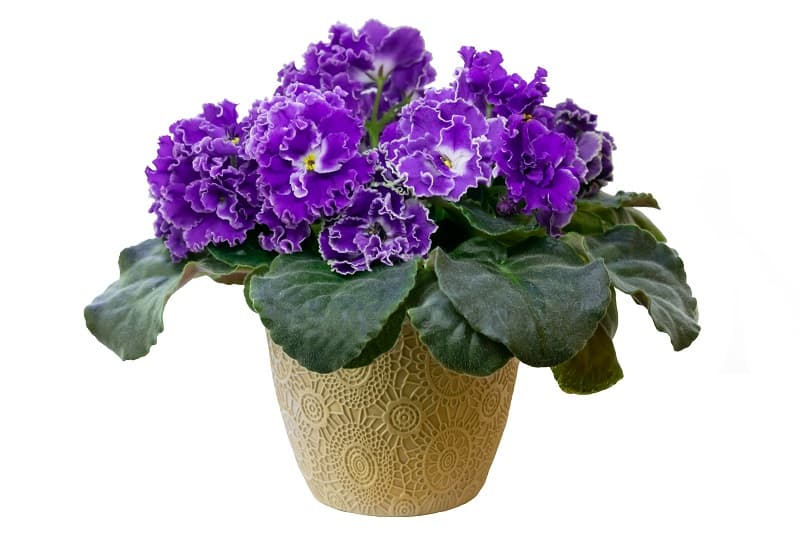
African violets are indoor plants favored for their dainty flowers, and can also be grown outdoors in certain climates. They are also known as saintpaulias, and some species are considered endangered. These flowering plants have round to oval leaves and a fleshy texture, and can grow up to five inches tall. Their flowers come in violet, purple, pale blue or white, and as with any plant, their leaves can sometimes turn yellow and discolored.
African Violets Leaves Turning Yellow: Common Reasons
1. It is part of the plant’s normal growth
As African violets grow, their older leaves on the outer ring will turn yellow. You can remove those yellowed older leaves as part of the routine grooming of your plants.
2. Due to water deficiency
If the soil is too dry, the result will be limp and yellow leaves.
3. Due to root crowding
The yellowing leaves could also be due to crowded roots. The roots may outgrow their planter and grow out of the drainage hole or protrude from the soil. This is an indicator that you should re-pot your plants.
4. Due to nutrient deficiency
Yellowing leaves, especially on the upper part of your African violets, indicates a lack of nutrients. Make sure you fertilize your plants to avoid this.
5. Due to light deficiency
African violet leaves could turn yellow due to insufficient light. If your plants are placed in a dark corner they cannot access sunlight, and as a result the leaves will start to turn yellow. This yellowing usually starts in the lower ring of leaves.
6. Due to cold drafts
If your African violets are placed near an air-conditioning system or an open window, they tend to suffer from cold drafts. Their leaves will start to turn yellow and become limp or mushy. To prevent this, move your plants to an area that is free of cold drafts.
7. Due to infection or disease
If you notice that the yellowing of leaves happens in patches or blotches, it could indicate an infection or disease, or a pest infestation.
Aside from the reasons mentioned above, yellowing African violet leaves could also be due to overwatering, overfeeding, old age, incorrect humidity, or intense light.
Yellowing leaves should be removed as they could affect the health of your plants. The rest of the plant could be deprived of vital nutrients if the yellowed ones are not removed, since the plant tends to spend energy just to maintain the health of the yellowed leaves. It also looks unsightly if your African violets have too many yellowing leaves.
How To Avoid Yellow Leaves on African Violets
To avoid the development of yellow leaves on your African violets, here are some steps you can take:
- Be sure to monitor the water temperature and use only lukewarm water. Do not give your plants chlorinated water.
- These plants thrive in bright sunlight, so they should be grown in a brightly-lit and well-ventilated area. West-facing and southeast-facing windows are great locations for them.
- See to it that you mist your plants’ surroundings or place them alongside other plants to maintain the ideal humidity levels. You can also place a water-filled pebble tray and change the water every three or four days to avoid attracting fungus gnats and other pests.
- Spray neem oil on the flowers and foliage should there be a fungal infection or insect infestation.
- Apply a balanced liquid fertilizer at least once or twice a month during the growing season.
- Make sure to properly fertilize to fulfill the nutrient requirements. Always refer to the manufacturer’s instructions.
- Do not over-fertilize your African violets.
- It is necessary to leach the potting soil to remove excess salts and minerals. Your plants’ soil should be washed at least twice a year.
Caring for your African Violets
African violets thrive in good soil, and favorable mixes include peat moss, perlite and vermiculite.
These plants are quite picky when it comes to water, so stick with giving them lukewarm water.
Light intensity should be filtered, since light affects the growth of African violets. Turn the pots regularly so that the flowers do not have to reach for the light. Growing plants should be exposed to light for at least a few hours, or you can also supplement with grow lamps.
Conclusion
African violet leaves turning yellow could be caused by watering problems, root crowding, incorrect light, or nutrient deficiency. It could also be due to disease, pests or cold drafts.
Image: istockphoto.com / Leisan Rakhimova